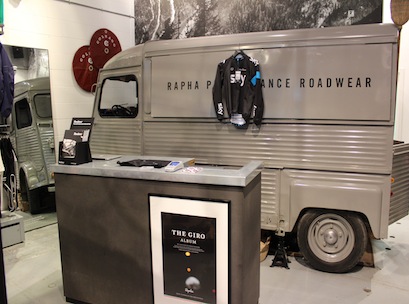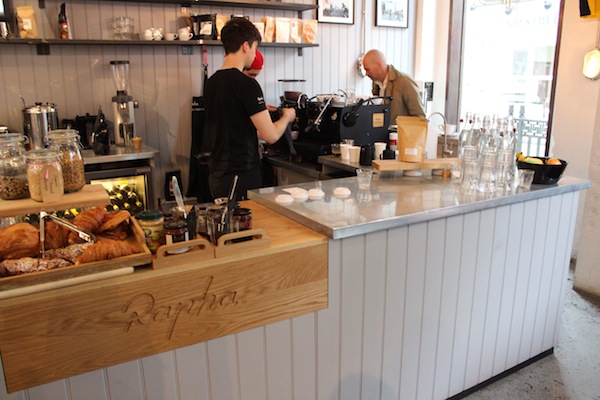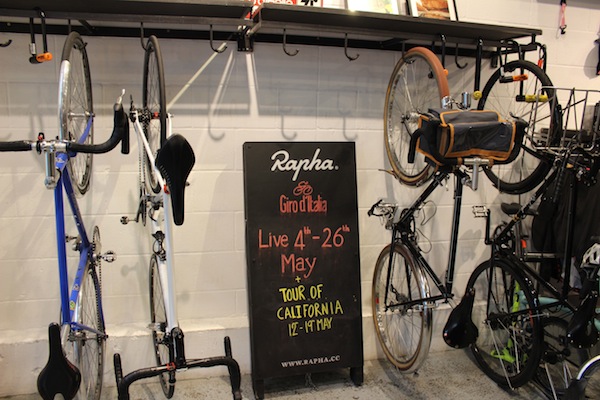 The Tour de France may be all wrapped up for the year, but for UK-based cyclewear and accessories brand, Rapha, the hard work continues year round.
The Tour de France may be all wrapped up for the year, but for UK-based cyclewear and accessories brand, Rapha, the hard work continues year round.
Founded in 2004 as a company dedicated to producing luxury cycling clothing, the original premise of Rapha was to sell product online only, and for the first six years of business, the company did just that.
Fast forward to 2013, and Rapha now has five stores globally, has hosted several pop up sites, and fostered an almost cult-like culture of cycle clubs and camaraderie among its followers.
On a visit to Rapha’s London store, Rapha’s head of retail, James Fairbank, took Westfield World Retail Study Tour attendees through the evolution of the brand. The Rapha concept was born out of founder Simon Mottram’s desire to make apparel for cyclists that understood the luxury market.
But Rapha’s greatest triumph is not its product (although it’s pretty good!) – it’s the personality and purpose of the brand that has drawn praise from the retail and cycling communities alike.
The stores, the first of which opened in San Francisco in 2010, are much more than a retail space.
Apparel sales and accessories account for the majority of store sales, with a café generating the balance. Add to this a cycle club run from each store and a series of screens streaming road cycling races 24/7, and you have a winning combination.
The newest store opened in Sydney on Crown St, Surry Hills in June, joining stores in London, San Francisco, Tokyo, and Osaka. New York is also on the way.
“In 2009 we started to think of somewhere to watch racing,” Fairbank told delegates from the floor of the London store.
“Once we’d done those three we realised we had something which could work financially, so we started thinking about doing permanent spaces.”
A pop up concept began trading on this premise in 2010 on London’s Clerkenwell Rd, and proved successful enough for the brand to trial similar pop ups in New York and Tokyo.
“It was very difficult to find somewhere to meet like minded people to watch racing, so we thought we’d look at producing a retail space which was part cafe, part experiential, and part store.”
Café
Original plans were for the business to be split 40/60 across food and beverage and retail, however, the reality is much lower for the café space.
“It’s turned out to be less than 20 per cent, although it’s increasing all the time,” Fairbank says.
“It’s very difficult to get a sense of how important the café is, because if you took away the cafe the general atmosphere just wouldn’t be the same.
Standing in the store looking at screens when you haven’t got a good reason to linger is not going to work.”
“Our company aim is to lead the luxury cycling market and beyond that it’s to try and help make road cycling the most popular sport in the world.
“It’s important the quality of the retail and the clothing you see is mirrored by the experience you have in the cafe.”
Rapha’s coffee is considered among the best in London, with heavy investment going into barista staff.
Retail
Rapha’s own range of men’s and women’s cycling apparel and accessories is boosted by a range of peripheral products, including cycling music and international magazines.
The typical Rapha customer is predominantly male, aged in their late 20s to 60s, time poor, well educated, and married.
Female customers are increasing, with a goal to grow women’s current 10 per cent share of sales to 20 per cent.
Stores have two main drops of product per year (eat your heart out Zara), with special editions such as a previous collaboration with designer, Paul Smith, run throughout the year.
E-commerce and bricks and mortar account for 85 per cent of total sales, with wholesale making up the balance, although the intention is to grow Rapha’s own controlled business to 90 per cent.
Online, Rapha’s average order value is around US$180.
“You get very drunk on the fact that you are selling the product directly, so the margin gives us so much more marketing flexibility,” says Fairbank.
Experiential
The experiential side of the Rapha business, while not revenue generating, is the chief reason customers return to the store.
A cycle club operates from each of its premises, which sees rides take place several times a week, while staff make time to go on impromptu rides with customers. During the key road cycling tours – all of which are streamed live instore – special events are held instore.
Outside of the store environment, but intrinsic to Rapha’s brand and authenticity are its short cycling films, photography, and a travel arm which hosts riding retreats and point to point cycles.
In addition to these activities, it is a sponsor of professional road cycling team, Team Sky.
“We think that sponsoring professional cyclists is important because the feedback that they put into the clothing gives us a legitimacy.
“Experiential retail is something that we are more aware of now,” says Fairbank.
“We really never started the company thinking we were going to do bricks and mortar, but we realise that its going to be a key part of our business for the next five, 10, 20 years and beyond.
“To be able to provide a space like this where people can come in and spend time means we have people coming here on daily basis to watch the racing.
“That translates very well into sales because they pick up the odd piece while they are here, as opposed to the old model where you are trying to encourage people through the door on a monthly basis.
“We’re much more about trying to get people engaged with the place.” Despite the success of the current apparel and cycling products offer, Rapha has no intention to move into cycling hardware or bicycles, with Fairbank of the belief that this side of the market is already adequately serviced.
The expansion of bricks and mortar stores, however, is high on the agenda, with the brand expecting to have 15 stores within the next three years, including a second Australian store in Melbourne.
“We find it very fortunate that we’ve got a history of online retailing because we know exactly where our customers are and we know exactly how to communicate with them, so when we open spaces, it’s easy to drive footfall to get to a certain level,” says Fairbank.
“Our company aim is to lead the luxury cycling market and beyond that it’s to try and help make road cycling the most popular sport in the world.”
This story originally appeared in Inside Retail Magazine’s August/September 2013 edition as part of our exclusive coverage on the 2013 Westfield World Retail Study Tour.
Inside Retail Magazine’s December/January 2014 issue, featuring Inside Retail Magazine’s annual Shopping Centre Developments Guide 2014 is available now. For more information, click here.








